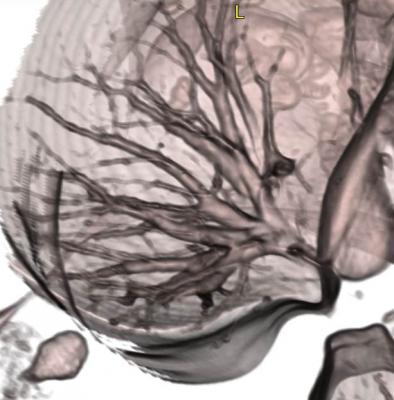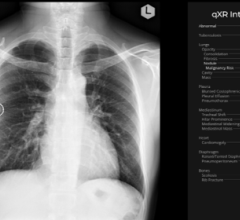
January 25, 2017 — Implementing lung cancer screening as a high-quality preventive health service in a community setting is feasible, but comes with several key challenges, according to a scientific presentation at the 53rd Annual Meeting of The Society of Thoracic Surgeons.
“Successful implementation of lung cancer screening will help reduce death from lung cancer,” said Doraid Jarrar, M.D., from the Perelman School of Medicine at the University of Pennsylvania, Philadelphia, who led the study. “But unfortunately, lung cancer screening does not share the same broad support from the public and the government as do breast and colon cancer screening. In addition, lung cancer remains stigmatized because of its association with cigarette smoking.”
Jarrar, Simran Randhawa, M.D., of Einstein Healthcare Network in Philadelphia, and colleagues conducted a 12-month prospective study of eligible patients at Einstein. Data were collected using the American College of Radiology (ACR) Lung Imaging Reporting and Data System (Lung-RADS) and compared to corresponding data from Einstein’s Tumor Registry. A lung navigator confirmed eligibility of 278 patients using National Lung Screening Trial (NLST) criteria and provided feedback to patients and referring physicians.
The analysis showed that 87 percent (242) of the eligible patients were categorized as Lung-RADS 1 or 2 (negative or benign appearance), 7 percent (21 patients) were LungRADS 3 (probably benign), and 5 percent (15 patients) were LungRADS 4 (suspicious with a chance of malignancy). Of the LungRADS 4 patients, four ultimately underwent anatomic resection for stage I non-small cell lung cancer.
At the end of the study period, a survey was distributed to all primary care and referring physicians. It showed that 100 percent of primary care providers were aware of the screening program, but 15 percent never referred a patient. The researchers also learned that 26 percent of providers were not aware that low-dose computed tomography (LDCT) scans for select patients at risk for lung cancer are recommended by the U.S. Preventive Services Task Force (USPSTF) in the same way that colonoscopy and mammography are urged for colon and breast cancers, respectively.
Since most people with early lung cancer have few or no symptoms, screening for those at high risk is critical. NLST findings published in 2011 showed that LDCT scans reduce the risk of dying from lung cancer in high-risk populations by as much as 20 percent. Based on those results, in 2013, the USPSTF recommended annual lung cancer screening with LDCT; in 2015, the Centers for Medicare & Medicaid Services (CMS) adopted similar recommendations.
Patient recruitment into any community lung cancer screening program is crucial to a successful, sustained effort. The lung cancer screening program that was part of this study was promoted through flyers, radio programs, face-to-face information sessions and a multidisciplinary lung symposium. Awareness campaigns such as these, in addition to educational resources that clearly outline eligibility criteria as well as benefits and risks of screening, should be made readily available. “Many times, patients will read a story in the newspaper or on the internet, see a story on TV, or hear one on the radio about how screening saved someone’s life. That is encouraging and motivating for patients who are considering lung cancer screening,” Randhawa said.
In a community setting, though, the primary care physician often remains the first touch and the best source of information. “Primary care physicians help patients with informed decision making,” said Jarrar. “They know the patient best, understand the risk factors of lung cancer, and are able to recognize those who meet the criteria for screening.”
However, this study revealed that many primary care physicians do not discuss lung cancer screening with their patients. The research team reported that there is often resistance from both sides when talking about lung cancer. Patients may not be receptive to discussing lung cancer and may refuse screening even when it is paid for by Medicare and other payers; providers may refrain from consultation regarding lung cancer screening for fear of intimidating patients. In addition, physicians and patients are often frustrated and discouraged by the delays resulting from precertification required by commercial insurers, as well as the time constraints related to fulfilling Centers for Medicare and Medicaid Services (CMS) requirements.
“Patients’ willingness and ability to undergo lung cancer screening and possibly surgery can be challenging,” said Jarrar. “It demands effective communication and strong documentation by using various risk-assessment models and shared decision-making tools.”
Interestingly, the research group discovered through follow-up phone calls with providers that the rate of referrals increased after the researchers shared positive feedback (i.e., if a provider referred a patient and early lung cancer was found). “With this information, physicians became further convinced that lung cancer screening was beneficial, and they really became champions in their practice for lung cancer screening,” said Randhawa.
Another concern identified from this research was that some primary care physicians were not aware which patients were eligible for screening (those who have a 30 pack-year smoking history and currently smoke or have quit within the past 15 years).
In addition to the screening, Jarrar recommended that these patients be encouraged to enroll in tobacco cessation programs. “Lung cancer screening combined with tobacco cessation is cost-effective for our healthcare system and actually saves money; more importantly, it saves lives by avoiding costly care for patients with advanced lung cancer and identifying cancer when a cure is still possible,” he said.
As learned from previous efforts in the fields of breast and colon cancers, a screening service must be widely available to eligible patients considering participation and be delivered efficiently and economically in order to optimize the public health benefit. To date, evidence-based guidance for implementing LDCT screening programs has not been determined.
“The development and disciplined implementation of lung cancer screening in communities will undoubtedly continue to evolve over time, as will the technology used for screening” said Randhawa. “In addition, we hope there will be better and increased access to screening. For patients, this means more hope and more lives saved.”
Lung cancer is the leading cause of cancer death, with more people dying of lung cancer than of colon, breast, and prostate cancers combined. The American Cancer Society estimated that more than 222,500 Americans will be diagnosed with lung cancer this year, and more than 155,000 lung cancer patients will die.
The other authors of the study were Gary S. Drizin, M.D., Thaer Obeid, M.D., Tracy Kane, M.D., Grace Y. Song, M.D., and Thomas J. Reilly, M.D.
For more information: www.sts.org


 December 10, 2025
December 10, 2025 









